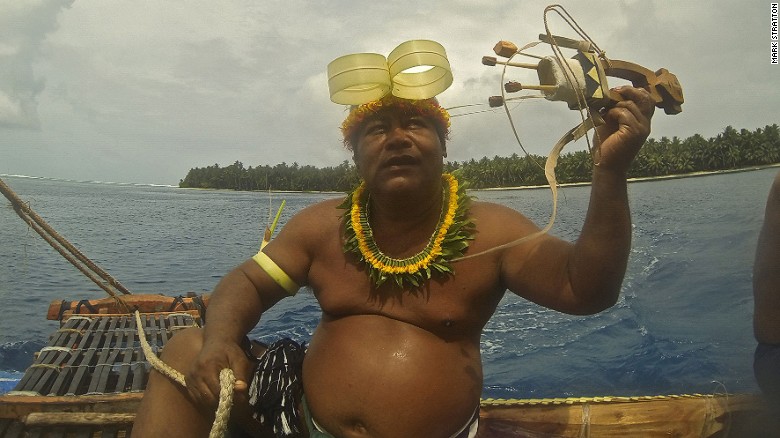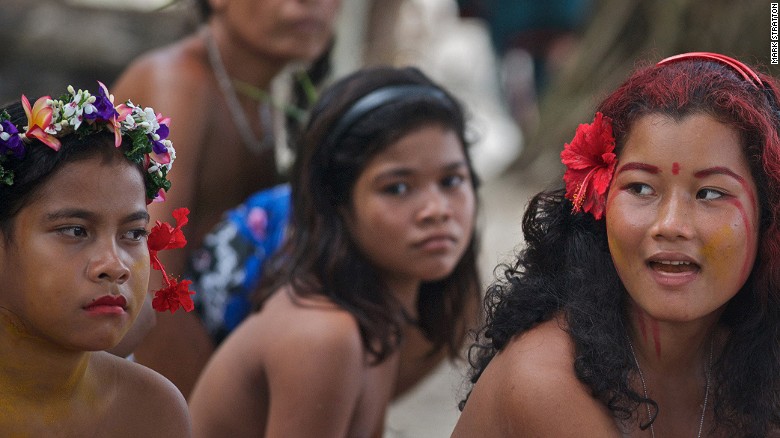Like other atolls, Lamotrek has seen its population slowly dwindle to around 329 islanders.
"Losing the young is one of the main threats to the atolls," Walter concurs. "It's difficult to imagine them wanting to continue to live under the same conditions as before.
"Even if they came back to these islands what would they do?"
But he argues that those leaving are a financial benefit to those remaining.
"The money generated abroad and sent home could never be obtained by those staying on their atoll," he says.
Stellar navigation
One skill under threat is the Micronesians' startling ability to negotiate the open Pacific by stellar navigation.
On a wooden outrigger canoe, islander Celestine takes me around Lamotrek Lagoon.
He holds Micronesia's most revered title: Master Pwo Navigator.
With pinpoint accuracy he can cross hundreds of miles of ocean without modern instrumentation, using only stars and ocean currents.
"Our children sail their first canoe around six years old," says Celestine. "Now they don't stay here long enough to learn proper navigation."
Celestine once made the 240-nautical-mile voyage west to our next port-of-call, Woleai Atoll.
Strict dress code
Woleai is conservatively traditional and strict dress code is required.
Both sexes wear palm-fiber woven lap-lap sarongs and are bare-chested.
Their undress reveals home-inked tattoos featuring nautical or Catholic motifs.
On the beach, young men haul tuna onto the sand and slice into its pink flesh with bamboo knives -- the freshest sashimi imaginable.
Frigate birds, the ocean's free-roving pirates, circle on high, eyeing a fishy meal.
Woleaian elder Martin Yangirelmar works for Yap State's education department.
His third-grade elementary schoolchildren are demonstrating traditional crafts.
The girls weave vivid lap-lap loincloths from banana and hibiscus thread; boys construct fish traps from bamboo.
Traditional skills
"We teach them traditional skills at an early age so at least they'll remember their heritage when they've left," says Yangirelmar.
"All these children will go to the larger Yap Island to study, staying with relatives and then eventually traveling further away in the future for work once they get a taste of Western culture.
"What you see here is dying out. I think in 20 to 50 years some atoll populations may no longer be here."
Some, however, are determinedly hanging on.
Ngulu Atoll
On Micronesia's westernmost frontier, most of Ngulu Atoll's population has long departed.
The eight remaining islanders are all members of the Mangthaw family.
A temporary ninth resident is cousin Henry.
He came to help rebuild after Typhoon Hagupit wrought havoc on Ngulu in December 2014.
He doesn't seem to mind the fact that he's been waiting two months for a cargo boat back home to Yap.
The typhoon has left the creamy beaches littered with fallen coconut palms, like matchsticks tipped from a box.
"When the cyclone struck big waves drove across the island," says George Mangthaw. "We were scared.
"We survived because of a brick shelter funded by the European Union."
TV, automobiles and convenience food
Mangthaw says a decade back Ngulu had 20 islanders.
Now, he's disdainful of their decision to leave for Yap.
"They went to drive cars, watch television and eat convenience food like chicken," he mocks.
He says he won't leave Ngulu because he's free to live exactly how he chooses.
"I think we will continue to find 'caretakers' for the families still residing on the atolls," says Christian Walter.
"But eventually the young population will look for brighter lights in other parts of the Pacific or the world."


No comments:
Post a Comment